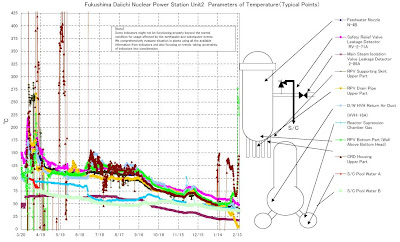Mr. Nakate is the head of "Fukushima Network to Protect Children from Radiation (子どもを放射能から守る福島ネットワーク)". He held a talk, one of the series, on January 17, 2012 in Sapporo, Hokkaido. He said he would be moving to Hokkaido himself. Fukushima was now almost forgotten by people in Japan, he said.
Following is from his talk as compiled into the togetthers (here and here, if you read Japanese) created by people who watched the USTREAM (archived here, nearly 2 hours).
"What is happening in Fukushima Now: What has happened to the children in Fukushima, where the contamination level far exceeds that from the Chernobyl accident? What are the responsibilities of the adults?"
Looking back on the March 11 nuclear accident:
3/13にはポータブルのものでもはっきり測れる程の異常がでていた。文部省には原子力研究所があり、測定の専門家がいる。率直にいえばマニアックな人達 で、平気で計測し、平気でHPに公開していた。でも、私達にはその数字がわからなかった。数百倍、場所によっては数千倍の線量だったのに。
On March 13, the radiation levels were so abnormal that even a portable survey meter could tell. The Ministry of Education and Science has the nuclear research lab [JAEA?] and there are specialists who measure radiation. They are nuclear science geeks, frankly, who measured the radiation levels and published the results on the homepage. But we didn't know what those numbers meant. They were hundreds of times, even thousands of times more than the normal levels.
NHK・ETV取材班によれば、文部省が測った数値、浪江の対馬地区・赤宇木は333μSv/hだった。通常0.03~0.06程。3時間で1mSv、1 日で8mSv、3日で今の避難基準を超える。一週間いれば、原発作業員でさえ絶対ありえない、まさに「ただちに健康に影響がでるような」数値に。
According to NHK's ETV, the Ministry of Education measured 333 microsieverts/hour in Akougi in Tsushima District of Namie-machi. The normal levels were 0.03 to 0.06 microsievert/hour. 1 millisievert in 3 hours, 8 millisieverts in one day, and in 3 days it would have exceeded the current standard for evacuation [20 millisieverts]. If you stayed for one week, it would have been the level which "would affect the health immediately". It would have been the level not even the nuclear plant workers are exposed.
立派な機材を積んだモニタリングカーがその辺を計測してまわり、その傍らには何も知らない住民たちが日常を送っていた。浪江の対馬地区は、原発の南西 30km位のところで、3/12に避難指示がでたため、20km圏内の人が避難してきていた。避難してきたはずが何十倍も被曝してしまった。
A monitoring car with good equipment came and measured the radiation levels. The residents continued to live there, knowing nothing. Tsushima District of Namie-machi is located at about 30 kilometers southwest [sic. it is northwest] of the plant, and many people inside the 20-kilometer radius evacuated there after the evacuation order was issued on March 12. They were supposed to have escaped from radiation, but they ended up getting irradiated several tens of times more.
(地図を示しながら)この阿武隈山地が防波堤のように防いでくれていた。が、3/15の波は阿武隈山地も乗り越えて、大量の放射能が中通り、新幹線の通る 一帯、福島や郡山のあるところまで達してしまった。そして隠ぺい工作、安全デマが福島県内を覆いつくした、市民には真実は伝えられなかった。
(Showing the map) This Abukuma Mountains acted like a breakwater [against radioactive materials). But the wave on March 15 went over the mountains, and a large amount of radioactive materials reached Nakadori [middle 3rd of Fukushima], areas where the Shinkansen bullet train runs, Fukushima City, and Koriyama City. Then the cover-ups and "safety" propaganda completely engulfed Fukushima. Residents were not told the truth.
そこで住民は普通の暮らしをしていた。情報の隠蔽、安全デマがものすごい勢いで福島県内に押し寄せ、被曝を拡大させた。正直、住民は大丈夫だよ、と言って欲しかった。安全を裏付ける情報を必死で求めた。そういう状況だった。ただ、やはり本当の情報が必要だと思った。
People were living the normal lives. Information was hidden, and the "safety" propaganda flooded Fukushima, causing even more exposure to radiation for the residents. To be honest, the residents wanted to be told "It's OK, nothing to worry about." They did all they could to look for information that would support "safety". That was how it was. I thought we needed the real information.
(to be continued)
It is perfectly understandable that Fukushima residents wanted assurance from the authorities in the early days of the accident. Everyone did. They wanted to believe the word of Yukio Edano, Chief Cabinet Secretary and the mouthpiece of the Kan administration, when he told the nation "There is no immediate effect on health". Now we all know that he only meant the radiation levels were not going to cause acute radiation poisoning.
After all, for more than a half century, the majority of the Japanese believed nuclear power was safe, and that Japan was leading the world by peaceful use of atomic energy. Despite the Fukushima accident, the majority still do, this time with the added delusion that nuclear power is necessary to prevent global warming.
That aside, I wonder if the US government, military or the NRC had anything to say to the Japanese counterparts about the way the Japanese authorities were not informing the people in Japan about the disaster and the danger of radiation exposure. They raised issues with how the Japanese government was handling the plant accident. Since they had access to SPEEDI data from very early on, thanks to Jerome Ryan, Second Secretary in the Political Section of U.S. Embassy Tokyo, they must have also known about the extremely high radiation levels in wide areas outside the immediate vicinity of the plant, and that people continued to live in places like Namie-machi and Iitate-mura, which were finally designated as planned evacuation zone in late April.
I wonder if they were OK with the cover-ups and safety lies.

















 Tokyo Time
Tokyo Time
![[Most Recent Quotes from www.kitco.com]](http://www.kitconet.com/charts/metals/gold/t24_au_en_usoz_2.gif)

